- Advertising
- Find the Magazine
- Good Jibes Podcast
- Boat In Dining
- Sailboat Charters
- Business News
- Working Waterfront
- Youth Sailing

- General Sailing
- Maritime History
- Sailing Records
- West Coast Sailing

The Cult of the Cal 40
The classic 1960s ocean racing legend.
The Cal 40 is a roughly 39-ft 4-in fiberglass production racing and cruising sailboat, of which about 155 were built in Costa Mesa, California, starting in 1963. The first mass-produced sailboat that was capable of sustained surfing on waves, the Cal 40 dominated ocean racing during the 1960s like no other design before or since. It’s the original longboard, a Southern California surfing machine that is capable of sustained 15-knot downwind speeds.
The Boat That Changed Everything
This breakthrough design ushered in dramatic changes in offshore racing, from the moment that Cal 40 #2, Conquistador, won the 1964 Southern Ocean Racing Conference, the marquee big boat series at the time. “Wooden ships and iron men” had been replaced by fiberglass boats and kids, as Cal 40s, sometimes crewed by teams of teenagers, crushed the competition in the Bermuda Race, the Transpac and many others.
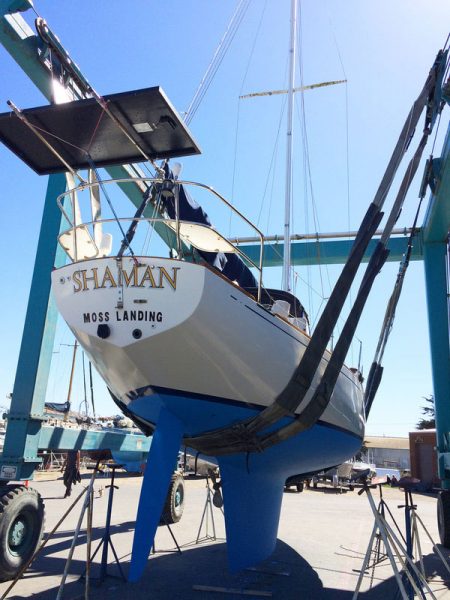
The Cal 40 was created as the combined work of three men. George Griffith, a successful racing sailor and member of the Los Angeles Yacht Club, reportedly drew the outline of a new kind of racing yacht hull on the back of a napkin, and showed it to his friend, naval architect C. William Lapworth. Griffith observed that sailing dinghies, like the International 14 class, were extremely maneuverable with their rudders hanging on their transoms, unlike the typical 40-footer of 1962, which was a full-keeled, heavy beast with the rudder swinging on the back of the keel.
Radical Ultralight Hull
Griffith’s sketch showed a flat-bottomed, radically ultralight hull, lithe and canoe-like in shape, but with a brutal, trapezoidal 6,000-pound wing stuck to the bottom. And behind this wing of a keel, way back, was a separate “spade” rudder. The design that Bill Lapworth created, at 15,000 pounds, was considered questionable, radically light and dangerously underbuilt by many of the yachting authorities, not to mention its being built out of the avant-garde new boatbuilding material of fiberglass, referred to as “extruded snot” by the esteemed L. Francis Herreshoff.
Griffith and Lapworth unsuccessfully shopped their design around to several California boatbuilders, experiencing polite rejection until they showed the plans to Jack Jensen, who agreed to build the boat on the condition that Griffith could guarantee orders for at least ten boats.
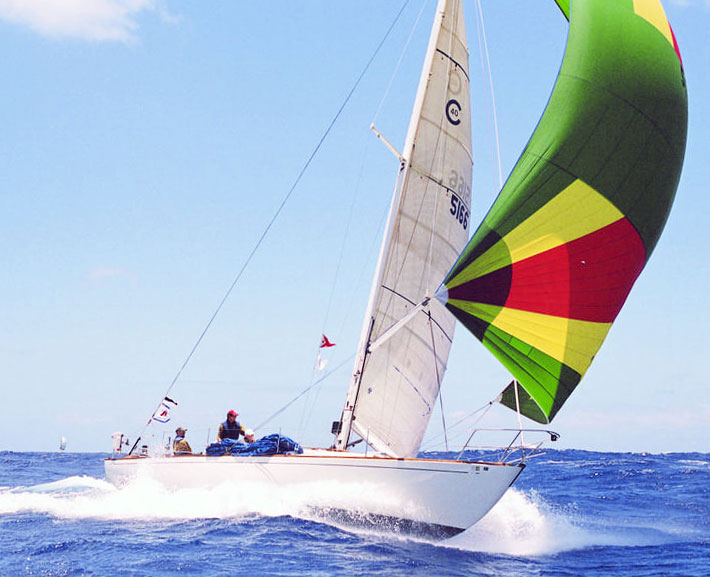
Fast forward to the present, and today the Cal 40 has attained true ‘cult’ status as a design that is sought after, restored and passed down through multiple generations of families. Try searching for Cal 40s that are for sale on Yachtworld and other sites, and you’ll likely come up empty. Folks spend multiple years and a quarter of a million dollars restoring Cal 40s and fitting them out with the latest sails, gear and electronics.
Standing the Test of Time
The Cal 40 has endured because it is not only a relatively quick downwind raceboat, but also a sweet-sailing light cruiser that, in the words of Cal 40 owner Stan Honey , “has no bad habits.” It steers beautifully under autopilot — plus it is rare to find a tiller-steered 40-ft sailboat, especially one with a light helm.
Cal 40s have twice achieved the record of being the biggest one-design fleet ever in the biennial Transpac Race, with 14 boats in 1966 and 2005. And the boat continues to rack up trophies in big ocean races too, as San Francisco Bay-based Cal 40s have continued to place well. Azure, Rodney Pimentel’s Encinal-based program, has been consistently near the top of the fleet in Bay, coastal and Pacific races. Green Buffalo and Red Head , from Richmond Yacht Club, have won at the top level. And no list of modern-era Cal 40 accomplishments is complete without mention of the husband/wife team of Stan Honey and Sally Lindsay Honey onboard Illusion .
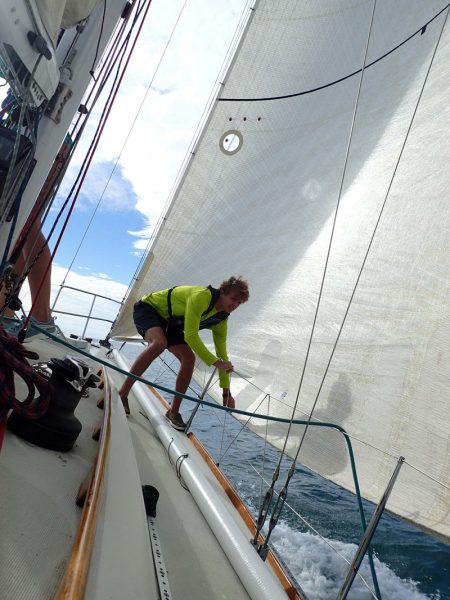
Many Cal 40 restorations are underway, or have happened recently. Fred Cook ’s complete down-to-bare-glass rebuild of Sequoia , documented in a great series of videos, is the most famous one. He’s worked with Cree Partridge, Jim Antrim, Kame Richards and other top East Bay pros to create a virtually brand-new boat.
A Swell Cal 40 Voyage
Perhaps the most well-known Cal 40 belongs to Liz Clark , who has been roaming the Pacific aboard Cal 40 #68, Swell . On what she calls, “a sailing surfer’s voyage of awakening,” Captain Clark has pushed the boundaries of solo cruising and sustainable living, all while attracting notice for her exciting adventures and sponsorship from the likes of Patagonia and North Sails. We have a copy of her excellent narrative, a book called Swell , onboard Shaman .

27 Comments
I own #120, ‘Mahalo’ and have since 2007. Yes, spent lots of $$ but she was in great shape after two Transpacs in ’03 and ’05 as ‘Flying Cloud’. She’s small by modern standards but just a blast to sail. I don’t race but I love to sail a boat well and a 40 is just a joy. She’s a great cruising boat now too.
First I would like to thank Latitude 38 for providing the magazine over the years but its especially great now when away from the water! I did the Transpac last year on Bob Hortons Cal 40 “Highlander” from Tiburon. What a great ride out there on the Pacific, I can vouch for the surfing which became competitive on the boat to see who who get the highest speed, I won by topping out at 18.9 knots on a wave at about 3-4 in the morning!, We could gauge how fast we were going by the noise of the water and how high water was spraying above the lifelines.
I like Cal 40s fine, but not the V drive most of them have.
I remember sailing with Jon Andron and his father Mort on their Cal 40 out of Santa Barbara in 1966-69. I was living aboard my boat GJOA in the SB harbor then. A fast boat ,but many “old school” sailors did not trust the FRP boats and I remember wondering if those boats would just fall apart while racing. How times changed.
We love the Cal40 here on Monterey Bay as well where we have a group of solo sailors we call “The Usual Suspects” who enjoy slugging it out on a regular basis. The Cal40 is extremely well suited for solo sailing/racing with it’s long tiller, accessible trim lines, and ability to easily steer with one’s foot while grinding in the jib after tacking. Just ask Steve Gann on his Cal40, Boomer, who (at 78 yrs young) still has enough tricks up his sleeve to teach us “youngsters” a thing or two!!!
Love Cal 40’s. Sailed in 81 and 85 on Montgomery Street in TransPac. We won it all in 85. The boat is like a freight train on rails downwind in a blow. I have many wonderful memories. I love it that Cal 40’s are still competitive 6 decades later.
How about running some of the old stories about the Cal-40. One such story that comes to mind was about Stan Honey doing the single-handed transpac in his Cal-40. Something about him beating the time of all previous Cal-40’s that had ever done the trip.
Splendid summary, thank you! It is extraordinarily impressive that almost 50 years later the Cal 40 remains an icon: a formidable racing boat that is also a sea-kindly and practical cruising boat without bad habits
It is, perhaps, worth remembering that the Cal 40 did not spring fully formed from George Griffith’s imagination onto that cocktail napkin. The same George Griffith had collaborated with the same Bill Lapworth on a prototype for the Cal 40 which was also built in Cost Mesa. This was the Lapworth 36. George Griffith took delivery of hull #1. It shared many of the same characteristics, and 71 boats were built to become a premiere one design fleet on the West Coast. It too, was radically ultralight by the standards of the day at less than 11,000 pounds. It shared the same rig and sail plan, and many of the same hull and under-body characteristics. The L-36 still had a keel hung rudder so it was the spade rudder that was the quantum leap on the Cal 40. Like the Cal 40, a well maintained Lapworth 36 remains a formidable racing boat as well as a sea-kindly and practical cruising boat without bad habits.
Full disclosure: my Father had #71 built. It is still in our family, and I expect my sons to be sailing her for many decades to come.
So additional articles must follow to describe the “cult” group of Cal 20s, 29s and other Lapworth models such as the Pearson 44, etc…. the man knew how to conceptualize racing vessels way beyond the design of the times.
What about the 40’s hot little sister the Cal 39 (pic in 2-11-18 Lec Lat, Ode to Wet Bottom Girls), or “The Other Woman” Knot A Clew.
Little? I believe the Cal 39 is both longer and heavier. Ask Saildata.com
Unfortunately, SailData.com indicates that only 107 CAL-40’s were built, but I apparently have hull #168 and I believe the above information is correct that 170 were built. Perhaps SailData.com transposed the 7 and the 0 in their count. I have come across a few other errors in their data, albeit they are a very useful source most of the time.
The Cal 39 is certainly a fine yacht, but it is fundamentally an offshore cruiser with good performance rather than a racing design that can also be cruised comfortably.
Guess I could tell a few “old” Cal 40 stories. In the ’67 Transpac (not ’66 as written in the article above), there were 14 Cal 40s on the start line. HOLIDAY TOO, #24, won class and overall, the youngest crew to do so, and a record that still stands despite MORNING LIGHT’s professional attempt at besting it. Before the 2007 Transpac, and movie of the same name, Robbie Haines of the MORNING LIGHT Disney project called me up and wanted all HOLIDAY TOO’s ’67 crew birthdates. I thought this a little strange without an explanation and refused his request. Another memory: Before the 2003 Transpac Stan Honey invited George Griffith and Bill Lapworth aboard ILLUSION for a little visit while tied up at the Griffiths’ dock in Alamitos Bay. As we sat around in the cockpit, a little contentiousness erupted. George told how Lapworth had designed the rig to be 18″ shorter, but George held out for the “tall” rig, saying Lapwoth’s “stump” would have “killed” the boat. Then the subject of who designed the Cal 40’s spade rudder, of which both Lapworth and Griffith claimed credit, arose, and was not resolved before our friendly little reunion broke up. Good times. -skip
Good to read about the history and accomplishments, past and present, of the wonderful Cal 40. My family and I have enjoyed owning Chaparral, hull number 135, for more than two decades and agree whole heartedly with the positive statements and comments about this tried and true class of great sailboats. In over 50 years on the water, Chaparral has proven the point of being an excellent racer and cruiser by performing well in off shore racing, including crewed and single handed Transpacs, as well as sailing around the world in 16 months, with her previous owner, Hans Vielhauer. Cal 40s may be old, but they certainly are good, and so much fun to sail.
Jim Quanci’s beautifully maintained Cal 40 ‘Green Buffalo’ has a few miles and many wins under her keel! I enjoyed following GB out of the gate in the 2012 SHTP, which Jim and GB won. And of course GB has also competed successfully in several Pac Cups, and many Bay races. She’s a Cal 40 worth watching!
Can anyone fill in the history of Sally and Stan’s Illusion? There was a black Cal 40 on the East Coast by that name in the early ’70s – owned by Commodore Montesano and raced by him and Bus Mosbacher. Maybe you’ve enjoyed a famous Montesano Cooler on the lawn at Larchmont. Yup – one and the same. I raced on the East Coast Illusion as a junior and have wondered if it’s the same boat. Thanks for any ideas.
Yes Sally and my Cal40 ILLUSION is the same boat as owned by Bus Mosbacher and Vince Monte-Sano. We sailed ILLUSION around to the East Coast to do the Bermuda Race in 2020 which was cancelled. Our fallback was two terrific summers cruising in Maine. We’ll be racing ILLUSION in the upcoming Newport Bermuda Race in June 2022. Interestingly ILLUSION’s first Bermuda Race was in 1966 raced by Mosbacher and Monte-Sano in which she came second to the Cal40 Thunderbird. The seven Cal40’s swept the results that year.
I am the keeper of hull 147 (I think) under the name EnFin, located on the Great Lakes. Although her specific history has gaps, it’s believed she’s lived in the fresh water of Lake Ontario for all of her life. In my opinion the Cal-40 has the best cockpit and is…. sparse down below. The cramped galley and curved floor can be difficult to get used to, but in a >15kn beam reach she makes it tough for boats far lighter and newer to keep up.
It is the same ILLUSION as owned by Mosbacher and Montesano. Hull number 57. She used to be black. There are half hulls of her in the NYYC Model Room and in Larchmont YC. She used to have sail number 1700, probably because Weatherly, the 12 that Mosbacher sailed in the Cup had sail number 17.
Thanks Stan, that connects the dots and brings back lots of happy memories. Glad to know you’re continuing the fun. Good luck in June. TK
I crewed on an L40 owned by Dr. Ed DuBois out of Marina del Rey back In 1968 and 1969. It was a lot of fun even tough we weren’t very competitive. I’d love to know if that boat is still around. I have no remembrance of the name or numbers of the boat. Ryan Anderson
Was the Dubois L40 also named Duboius? I was best friends with Larry Dubois back then.
I remember racing against Laughing Sally in Puerto Rico early 1970s. Dick Doran was the helmsman. It was the most dominant and professional boat during those days. In 1970 won Antigua.
I’m the current care taker of 1970 built Cal-40 Jubilee. Almost done with a full refit here on the Gulfcoast near the Florida Alabama line. I was really enjoying the ride until starting on the long journey of redoing outside and in. Everything except the engine and transmission have been changed out. About to rig and step the mast soon. Hope to have her ready to go fall of ‘23.
Take good care! I learned to sail on Jubalee in the 80’s in Houston. She’s special. I’ve heard a photo of her was in the Charleston yacht club for a while.
There used to be a small plaque or something on the bulk head commentating a SORC record she set.
I have (should I say am trustee of? lol) a Cal-40 that is apparently Hull# 168, formerly named ‘Callalou’ or ‘Callaloo’, and now named ‘Innisfree’ likely after the Irish poet Yeats’ poem of the same name. I’ll keep her name as is. She needs some deferred maintenance caught up and rehabilitation. The teak is in need of cleaning and oiling and the cockpit backboards will most likely need replacing. The power plant is not original. She has a Westerbeke W-33 now, which was derived from a Perkins block; some parts are interchangeable. The engine starts and runs fine now with a new waterpump. I am eager to get her sailing again as I think she has awesome lines, not to mention all of the Cal-40 history and accolades I am learning more about. Any help with photographs of original cabin layouts, maintenance issues to look for, etc., will be greatly appreciated. Thank you in advance.
Leave a Comment Cancel Reply
Notify me via e-mail if anyone answers my comment.
Messages to the Neighbors Hoisting the Signal Flags "When you live in Sacramento like I do and miss sailing on San Francisco Bay with your buddies (like I do), what else was I supposed to do? I dug deep into my gear box…"
Sponsored Post Westwind Boat Detailing Washing, waxing, varnishing. Serving the entire Bay Area for more than 30 years. “I have never seen the teak look so good."
Commentary Following the Rules, Until You Don’t Today, New Zealand went from its “Level 4” lockdown — the highest, most strict tier — down to “Level 3.” More businesses will be allowed to open, and more activities will be allowed.
Subscribe to the Magazine Take a Break from Junk Mail with Latitude 38 “You are awesome and remind me how much MORE I like/crave/need the print version. I hope you don’t suspend it.”
- New Sailboats
- Sailboats 21-30ft
- Sailboats 31-35ft
- Sailboats 36-40ft
- Sailboats Over 40ft
- Sailboats Under 21feet
- used_sailboats
- Apps and Computer Programs
- Communications
- Fishfinders
- Handheld Electronics
- Plotters MFDS Rradar
- Wind, Speed & Depth Instruments
- Anchoring Mooring
- Running Rigging
- Sails Canvas
- Standing Rigging
- Diesel Engines
- Off Grid Energy
- Cleaning Waxing
- DIY Projects
- Repair, Tools & Materials
- Spare Parts
- Tools & Gadgets
- Cabin Comfort
- Ventilation
- Footwear Apparel
- Foul Weather Gear
- Mailport & PS Advisor
- Inside Practical Sailor Blog
- Activate My Web Access
- Reset Password
- Customer Service

- Free Newsletter

Catalina 270 vs. The Beneteau First 265 Used Boat Match-Up

Ericson 41 Used Boat Review

Mason 33 Used Boat Review

Beneteau 311, Catalina 310 and Hunter 326 Used Boat Comparison

Tips From A First “Sail” on the ICW

Tillerpilot Tips and Safety Cautions

Best Crimpers and Strippers for Fixing Marine Electrical Connectors

Thinking Through a Solar Power Installation

Polyester vs. Nylon Rode

Getting the Most Out of Older Sails

How (Not) to Tie Your Boat to a Dock

Stopping Mainsheet Twist

Fuel Lift Pump: Easy DIY Diesel Fuel System Diagnostic and Repair

Ensuring Safe Shorepower

Sinking? Check Your Stuffing Box

The Rain Catcher’s Guide

What Do You Do With Old Fiberglass Boats?

Boat Repairs for the Technically Illiterate

Boat Maintenance for the Technically Illiterate: Part 1

Whats the Best Way to Restore Clear Plastic Windows?

Giving Bugs the Big Goodbye

Galley Gadgets for the Cruising Sailor

Those Extras you Don’t Need But Love to Have

What’s the Best Sunscreen?

UV Clothing: Is It Worth the Hype?

Preparing Yourself for Solo Sailing

How to Select Crew for a Passage or Delivery

R. Tucker Thompson Tall Ship Youth Voyage

On Watch: This 60-Year-Old Hinckley Pilot 35 is Also a Working…

On Watch: America’s Cup

On Watch: All Eyes on Europe Sail Racing

Dear Readers
- Sailboat Reviews
Caliber 40 LRC
This well-built cruising boat with an attractive wood interior has loads of room but sails marginally to windward and has a few problems with its tanks..
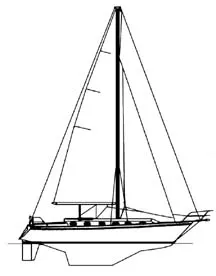
Brothers George and Michael McCreary, and Marshall Jones, formed Caliber Yachts Inc. as a backyard boatbuilding company in 1979. No strangers to the sailing world, the brothers grew up racing and cruising Florida and the Caribbean.
Following high school, Mike earned a degree in engineering, with a specialty in naval architecture, from the University of Michigan. He served his apprenticeship on the production line at Gulfstar Yachts, and as a designer for Endeavour Yachts.
George, who manages the business side, received a degree in business administration and marketing from the University of Florida, after which he spent three years working for Morgan Yachts.
Jones began studying the production side of the business immediately following graduation from high school when he went to work at Com-Pac Yachts.
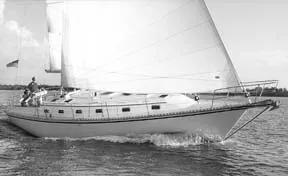
Without bank financing, Caliber Yachts began building boats one at a time, producing its first, a 28-footer, in 1981. By 1985 the company was sufficiently solvent to build a factory, and introduce a 33-footer. A 30, 35, 40, and 47 followed. The Long Range Cruising (LRC) line began in 1994.
George, who acts as company spokesman, says the construction and design of the LRC is similar to earlier models. The primary difference is expanded tankage for fuel and water.
The Caliber 40 LRC has a projected cruising range of 1,484 miles when motoring at 7 knots with a Yanmar 50 diesel running at 2,500 rpm.
George is tightlipped about information he considers proprietary—the company’s gross sales, annual production, and number of employees or dealers, for example.
Design Michael McCreary designed the 40 LRC, which is most often compared to an Island Packet.
It has a relatively fine entry, bowsprit and bobstay, straight sheer, reverse transom, and flat coachroof. The displacement/length ratio is a moderately hefty 281, indicating it has the hull volume to carry necessary cruising stores. A Valiant 40 is 256, a Sabre 38 224, and a J/40 176.
Ballast of 9,500 lbs. is 44% of displacement. McCreary says its limit of positive stability is 138°, well in excess of the 120 figure many consider minimum for offshore sailing.
The underbody shows a long cruising fin; you could also call it a full keel with a cutaway forefoot and a monster “Brewer bite.” The rudder is skeg-mounted for protection and tracking.
Shrouds are led to chainplates mounted inboard of the toerail, and the genoa track is close to the cabin for narrow sheeting angles.
McCreary claims the boat tacks through 85°-90°, but we were unable to approach those tacking angles during our test sail, nor have we heard from any owner capable of tacking through less than 96°, including one who invested $6,000 on flat cut, laminated sails.
Sail area is 739 sq. ft., with a sail area/displacement (SA/D) of 15.3; that compares to a Valiant 40 at 15.5, falling in the general range for offshore cruisers.
The company has built 130 40 LCRs since its introduction in 1994.
Construction McCreary would not provide a complete lamination schedule for publication because he considers the information proprietary and subject to misinterpretation. He said that buyers or owners who want that information should contact him directly.
However, he described the lay-up in general terms.
Hand lay-up of the solid glass hull begins with molds sprayed with isophthalic-neopentyl gelcoat, followed by a skin layer of .75-oz. split-strand fiberglass set in vinylester resin to prevent blistering.
The keel shape is part of the hull mold with a cavity for the iron and concrete ballast that is glassed over.
Though no molded liners or pans are used except in the heads (an appropriate application to deal with moisture from showers and toilet leaks), the hull is stiffened by the bonding in of a molded Integral Strength-Grid System™ that incorporates water and two fuel tanks.
The deck is cored with Marine Tech plywood cut into 2-7/8″ squares bedded in alternating layers of 1.5-oz. mat and 24-oz. roving. McCreary says that wood is used because it resists compression when deck hardware is installed, which he considers a shortcoming of balsa and foam cores. (Many builders using balsa or foam omit it where hardware is to be installed, and use wood or solid resin/glass.)
Extra layers of glass are laminated around the perimeter of the cabin and cockpit, and radiuses are reinforced with 18-oz. Fabmat.
The Quad-Seal Deck to Hull System™ is sturdy and well done. The deck and hull flanges are bonded with 3M 5200. The inside seam is bonded with copolymer tape. An L-shaped aluminum toerail covers the exterior seam; it is also bonded with 3M 5200 and fastened with stainless steel carriage bolts on 6″ centers. A stainless rubrail covers the seam between toerail and hull.
Caliber seems to have a name for everything, including conventional bonding of bulkheads to the hull. Caliber calls its method The Multi-Bulkhead Bonding System™. Furniture and cabinetry are bonded in the same manner. A built-up plywood interior bonded to the hull and deck is in many ways preferable to a one-piece fiberglass pan interior.
Chainplates are through-bolted to bulkheads as well as the deck. Caliber calls it the Double-Lock Chainplate System™.
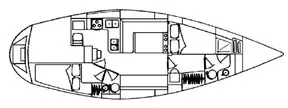
The molded rudder is constructed of a stainless steel plate welded to a 2″ diameter stainless steel stock encapsulated in fiberglass. When released from the mold, fiberglass tape is laid over the seam to prevent leaks, and the appendage is then faired and sprayed with gelcoat.
Loads on the rudderstock are handled by three supports: a solid stainless steel shoe attached to the bottom of the skeg, a bronze stuffing box at the waterline, and an upper bearing.
To offset the potential for contamination of fuel or water, boats are equipped with “Duel Diesel and Dual Fresh Water” system control panels with independent piping and filters.
However, while at the fuel dock the owners of our test boat complained that the fuel and water fillers are not marked, and are so close to each other that spilled fuel could enter the water filler.
Several owners think the boat’s holding tank incorporates a major design flaw. The 110-gal. integral tank is in the bow below the anchor locker. The aft side of the holding tank extends from the bottom of the hull to the deck, doubling as a watertight collision bulkhead.
The design provides structural integrity, but McCreary confirmed that when pumping out the tank it is critical that vent screens are clean; otherwise, a clogged vent may create sufficient suction on the holding tank wall to cause delamination of the hull. After talking with several owners, we think McCreary has understated the problem.
One owner experienced the problem when flushing the toilet while sailing offshore.
“As I pumped I heard a scary cracking sound in the holding tank,” he said. Upon inspection, he found the vent micro-screens were clogged. “When I opened the Y-valve I heard a major ‘whoosh’ as pressure was released,” he said.
Another owner said a more damaging result occurred under similar circumstances when the screen clogged and the top of the holding tank split away from the hull, creating an 11″ long crack, not to mention a horrible mess.
Additionally, a full holding tank adds 912 lbs. of weight in the bow, according to McCreary; coupled with anchor and rode, we think that is excessive. The holding tank also services the aft head, so waste may accumulate in hoses under the saloon.
The vacuum problem may extend to water and fuel tanks equipped with the same screens. One owner reported the inability to pump water from a tank, though the water pump was operating properly. The screens require cleaning or replacement.
Deck The T-shaped cockpit is comfortable, with 7′ 6″ seats and high backrests.
A port lazarette is 32″ deep and has a 16″ wide shelf and scallops for organizing spare lines. It also provides access to the aft end of the engine, batteries, and steering controls. There is space for the installation of a cabin heating system and genset.
Other features include an ice chest and vented propane locker with room for two 10-lb. bottles.
The transom platform has a built-in swim ladder.
For sail handling, two-speed Lewmar 48 winches are located on the coaming within reach of the helmsman, but the mainsheet traveler, mounted on the coachroof, requires a shorthanded sailor to leave the helm to trim the main. Two Lewmar 30s are mounted on the cabin top with triple rope clutches for sail control lines.
The untapered Selden mast has single spreaders.
The test boat was equipped with an optional inner forestay for setting a staysail. Tension on the stay is controlled by an uphaul inside the mast attached to a stainless sliding car to which the stay is attached. When not in service, the stay is secured out of the way to a padeye on deck.

The headstay and upper shrouds are 3/8″; the backstay and lower shrouds are 5/16″. The split backstay eases boarding but a single backstay would allow for an integral adjuster to control sail shape.
With wide decks, lifelines, handrails and slotted toerail, movement about the boat is easy and safe.
A double-roller stainless steel bowsprit moves ground tackle well forward of the stem and furling gear. The split anchor locker on our test boat carried a 30-kg Bruce, 200′ of chain and 200′ of rode in one compartment, and a 25-lb. Danforth and rode in the other.
Accommodations Joinerwork is nicely done; the 40 LRC looks like a traditional cruising boat—teak and holly sole, teak hull liners and bulkheads.
Headroom is 6′ 2″ throughout.
The master stateroom forward has an offset double berth measuring 6′ 4″ x 4′ 4″. It’s a nice change from the usual V-berth, though the person sleeping outboard has to climb over his or her partner to get out.
We like the head in the bow, but it won’t be as comfortable to use at sea as the aft head. There is a separate shower stall.
The L-shaped dinette settee to port is 6′ 2″ long, and converts to a double berth. The starboard settee is 6′. The dinette table folds down from the bulkhead.
In the galley, the fiberglass sink is located on centerline, where it should be to prevent water from flooding through the drain. The stove/oven is Force 10 and there’s room for a microwave. The 11 cu. ft. top loading icebox drains into a sump pump box at the mast step.
The nav station is aft of the galley. The navigator faces a large electrical and instrument panel outboard and communicates with the helmsman by opening a port beside his seat.
To starboard is what McCreary calls a “day head,” with doors from the saloon or aft berth. The head measures 42″ x 36″ and has toilet, sink and a shower; one dealer referred to it as a “telephone booth.”
The aft stateroom berth measures 6′ 7″x4′ 4″. There’s a cedar-lined hanging locker. Storage space below the berth is shared with an 11-gallon water heater.
Access to wiring, plumbing, through-hulls and tank inspection ports throughout the boat are from inside cabinets or behind fascias.
The top step on the companionway ladder opens to provide access to the top of engine; if desired, the entire ladder/box can be removed.
One owner complained that the engine compartment is inadequately insulated; he added lead-lined foam insulation but is still dissatisfied with engine noise in the saloon.
Performance Our test sail was with a Seattle couple that has owned four boats prior to the 40 LRC, most recently a light displacement, fin keel 36-footer.
“We didn’t want a full keel,” they said. “But we wanted a good shape, aesthetics, and a full-batten main and cutter rig so we could reef and sail with the staysail in 40 knots of breeze.
“The first thing we had to adapt to was the difference in feel and stiffness of this boat. It’s not as much fun as our old 36, but it is easier to sail.”
We tested the boat in 0-12 knots of apparent wind on calm waters, setting a 135% genoa on a Harken furler.
Considering its displacement, it is no surprise that in less than 6 knots of wind the boat moves only with assistance from the “iron genny.” When windspeed reached 6 knots it made 2-3 knots; at 7-9 knots of breeze we accelerated to 4.5 knots. Then, in 9-12 knots of wind, we sailed at 5-5.5 knots to within 60° of the apparent wind. On a broad reach, we managed to hit 7.2 knots in 10-12 knot puffs.
Additional performance information came from another Seattle owner who has logged more than 4,000 miles on his boat. A racer-turned-cruiser, he has pushed the boat hard and has computerized performance data. He replaced the factory main with a flat cut, large roach Spectra sail.
“I wanted to find out just how seaworthy the boat is, and how well she sails,” he said. “We sailed 250 miles to weather during a 36-hour trip up the west coast of Vancouver Island. Carried a 120% jib and full main sailing into 5-6 foot seas in steady 15-20-knot winds. I had a mapping program calibrated to my GPS and found that the best tacking angle we could produce was 112°.
“Going to weather in winds over 20 knots we furl the jib and hoist an overlapping staysail. We added sail track inside the Dorades to improve pointing and found that when wind speeds reach 20 knots we point 5° higher with the staysail, improve our VMG, and are more comfortable.
“On the return downwind we noticed a tendency to roll to windward in heavy seas, even with shortened headsail.”
Following an offshore passage from San Francisco to San Diego a cruising couple echoed his sentiments.
“When beam and broad reaching in winds around 25 knots the boat will round up if I have too much sail up,” the husband said. “When on a broad reach it gets even worse because the rollers hitting the stern push the stern to leeward, so it’s important to shorten sail early. On the other hand, I don’t think this was any worse than any other boat I’ve sailed on.”
A number of owners said they have fitted a feathering Max-Prop to the 50-hp. Yanmar diesel, which improves maneuverability, especially in reverse, and reduces drag under sail.
Warranty The company’s one-year warranty is too short, considering the price and intended use of the boat. The warranty for blistering is extended to five years if the bottom is epoxied during construction.
However, Chester Kolascz, a dealer who has represented the company for eight years in Michigan and also represents two other mainstream builders, said: “My service department likes Caliber best because it has the least amount of warranty work of any of the three.”
Conclusion The design and construction of the Caliber 40 LRC make it suitable for offshore use. In decent winds it should give 150-180-mile days. Upwind performance is typical of moderately heavy cruising boats; odds are she’ll be motorsailed on long coastal trips to weather. On balance, she’ll cover fewer miles than lighter-weight competitors, but will provide a more comfortable ride in heavy seas.
Among owners contacted, the company gets mixed reviews regarding post-sale service. In one instance the company shared the expense of a repair more than one year after expiration of the warranty.
Base price seems a fair $204,950, FOB Clearwater, Florida. For comparison, a Cabo Rico 40 is close to $400,000, a Catalina 40 Mk II and a Jeanneau Sun Fast 40 about $170,000, and the C&C 121 Express about $220,000.
Contact- Caliber Yachts, 4551 107th Circle N., Clearwater, FL 33762; 813/573-0627.
RELATED ARTICLES MORE FROM AUTHOR
Leave a reply cancel reply.
Log in to leave a comment
Latest Videos
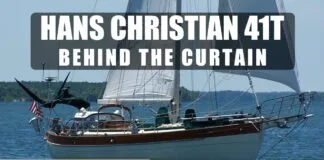
Hans Christian 41T – Boat Review

Seven dead after superyacht sinks off Sicily. Was the crew at...


What’s the Best Sailboats for Beginners?

Why Does A Sailboat Keel Fall Off?
Latest sailboat review.

- Privacy Policy
- Do Not Sell My Personal Information
- Online Account Activation
- Privacy Manager
- Practical Boat Owner
- Digital edition

Cal 40: The 1960s US classic that deserves restoration
- September 8, 2021
The Cal 40's traditional appearance belies her lightweight design and her surprising scarcity value, writes Rupert Holmes

Photos: PPL Photo Agency
The traditional styling of this boat, with its counter stern and raked bow, might lead onlookers to assume it’s a typical heavy long keeler from the early 1960s.
However, it’s a lightweight design with the potential to surf at speeds of 15-16 knots for sustained periods. Of course, when the Cal 40 was first launched in 1963 there were many naysayers, who couldn’t believe that such a light boat could be engineered to withstand the rigours of the ocean.
Yet the design won the 1965, 67 and 69 TransPac races, having sailed 2,250 miles from Los Angeles to Hawaii. Cal 40s also took positions 1, 3, 4, 5 and 6 in the 1966 Newport to Bermuda race.
Article continues below…

Island Packet 350: A boat that delivers you in style
This Florida-based yard has produced a range of distinctive long keel serious cruising designs for more than 40 years. These…

Legend 356 sailboat: Big in Britain but born in the USA
Hunter Marine became a major force in boatbuilding from the 1980s through to the financial crisis of 2008, with the…
So what was the secret to this boat’s success? Designer Bill Lapworth drew a radically flat bottomed boat by the standards of the early 1960s, with well balanced ends and a fin keel with a relatively long chord length.
The fairly narrow transom means the Cal 40 rolls downwind far more than today’s broad stern designs, but remains on course as it does so and the big spade rudder is easily able to retain control, even when sailing on autopilot.
Accommodation is in a traditional layout, with a good size forecabin, plus heads and stowage space between that and the saloon. This has two settees with pilot berths outboard and a folding central table.

There’s also a reasonable galley, large chart table and a pair of snug quarter berths. The Cal 40 has gained a semi-cult status over the years.
Well known owners include Volvo Ocean Race winning navigator and multiple sailing speed record holder Stan Honey and his wife Sally Lindsey Honey, a double winner of the USA’s Yachtswoman of the Year award.
Prices vary considerably, but even tired examples are becoming more expensive, while very well equipped and maintained boats can change hands for much higher figures than most boats of this era.
Cal 40 specification
LOA: 12.00m / 39ft 4in LWL: 9.25m / 30ft 4in Beam: 3.35m / 11ft 0in Draught: 1.70m / 5ft 7in Displacement: 6,800kg / 15,000lb Ballast: 2,700kg / 6,000lb Sail area: 65m2 / 700ft2 Current market value: £50,000-£120,000 / $68,000-$164,000
The Caliber 40 is a 40.92ft cutter designed by Michael McCreary and built in fiberglass by Caliber Yachts (USA) since 1992.
The Caliber 40 is a moderate weight sailboat which is under powered. It is very stable / stiff and has a good righting capability if capsized. It is best suited as a bluewater cruising boat. The fuel capacity is average. There is a good water supply range.
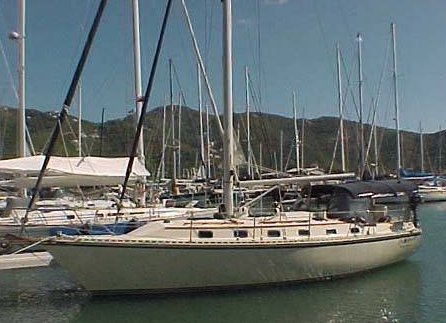
Caliber 40 for sale elsewhere on the web:

Main features
| Model | Caliber 40 | ||
| Length | 40.92 ft | ||
| Beam | 12.67 ft | ||
| Draft | 5 ft | ||
| Country | United states (North America) | ||
| Estimated price | $ 0 | ?? |
Login or register to personnalize this screen.
You will be able to pin external links of your choice.

See how Sailboatlab works in video
| Sail area / displ. | 0 | ?? | |
| Ballast / displ. | 43.98 % | ||
| Displ. / length | 280.90 | ||
| Comfort ratio | 32.39 | ||
| Capsize | 1.82 |
| Hull type | Monohull fin keel with rudder on skeg | ||
| Construction | Fiberglass | ||
| Waterline length | 32.50 ft | ||
| Maximum draft | 5 ft | ||
| Displacement | 21600 lbs | ||
| Ballast | 9500 lbs | ||
| Hull speed | 7.64 knots |

We help you build your own hydraulic steering system - Lecomble & Schmitt
| Rigging | Cutter | ||
| Sail area (100%) | 0 sq.ft | ?? | |
| Air draft | 0 ft | ?? | |
| Sail area fore | 0 sq.ft | ?? | |
| Sail area main | 0 sq.ft | ?? | |
| I | 0 ft | ?? | |
| J | 0 ft | ?? | |
| P | 0 ft | ?? | |
| E | 0 ft | ?? |
| Nb engines | 1 | ||
| Total power | 0 HP | ||
| Fuel capacity | 55 gals |
Accommodations
| Water capacity | 156 gals | ||
| Headroom | 0 ft | ||
| Nb of cabins | 0 | ||
| Nb of berths | 0 | ||
| Nb heads | 0 |
Builder data
| Builder | Caliber Yachts (USA) | ||
| Designer | Michael McCreary | ||
| First built | 1992 | ||
| Last built | 0 | ?? | |
| Number built | 0 | ?? |
Modal Title
The content of your modal.
Personalize your sailboat data sheet
- Types of Sailboats
- Parts of a Sailboat
- Cruising Boats
- Small Sailboats
- Design Basics
- Sailboats under 30'
- Sailboats 30'-35
- Sailboats 35'-40'
- Sailboats 40'-45'
- Sailboats 45'-50'
- Sailboats 50'-55'
- Sailboats over 55'
- Masts & Spars
- Knots, Bends & Hitches
- The 12v Energy Equation
- Electronics & Instrumentation
- Build Your Own Boat
- Buying a Used Boat
- Choosing Accessories
- Living on a Boat
- Cruising Offshore
- Sailing in the Caribbean
- Anchoring Skills
- Sailing Authors & Their Writings
- Mary's Journal
- Nautical Terms
- Cruising Sailboats for Sale
- List your Boat for Sale Here!
- Used Sailing Equipment for Sale
- Sell Your Unwanted Gear
- Sailing eBooks: Download them here!
- Your Sailboats
- Your Sailing Stories
- Your Fishing Stories
- Advertising
- What's New?
- Chartering a Sailboat
- Cruising Yachts 45' to 50'
- Caliber 40 LRC
The Caliber 40 LRC Sailboat Specs & Key Performance Indicators
The Caliber 40 LRC, a robust long-range cruiser sailboat, is a creation from the drawing board of Michael McCreary, an American designer. This sailboat exemplifies a blend of endurance and comfort for long-distance sailing.
It is built by Caliber Yachts, a company established and located in Clearwater, Florida. Caliber Yachts is renowned for its commitment to quality and durability, focusing on crafting vessels that cater to serious cruisers.
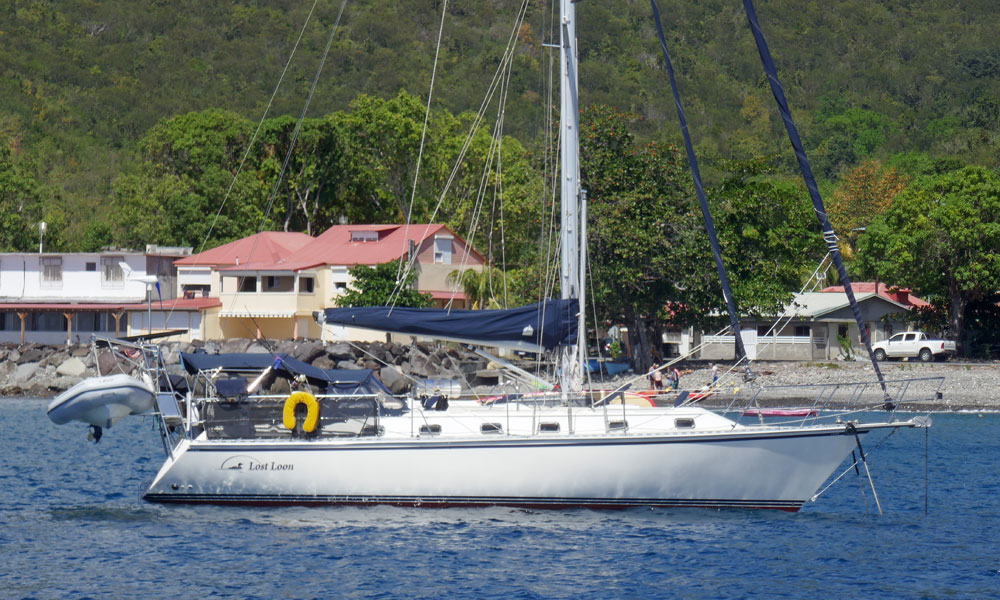
Brothers George and Michael McCreary, together with Marshall Jones, formed Caliber Yachts Inc. as a backyard boatbuilding company in 1979. Without bank financing, Caliber Yachts began building boats one at a time, producing its first, a 28-footer, in 1981. By 1985 the company was sufficiently solvent to build a factory, and introduce a 33-footer. A 30, 35, 40, and 47 followed. The Long Range Cruising (LRC) line began in 1994. The Caliber 40 LRC has a projected cruising range of 1,484 miles when motoring at 7 knots with a Yanmar 50 diesel running at 2,500 rpm.
Published Specification for the Caliber 40 LRC
Underwater Profile: Fin keel with skeg-hung rudder
Hull Material: GRP
Length Overall: 40'11" (12.5m)
Waterline Length: 32'6" (9.9m)
Beam: 12'8" (3.9m)
Draft: 5'0" (1.5m)
Rig Type: Cutter
Displacement: 21,600lb (9,798kg)
Designer: Michael McCreary
Builder: Caliber Yachts (USA)
Year First Built: 1995
Published Design Ratios for the Caliber 40 LRC
The Caliber 40 LRC sailboat, with its design ratios, offers a unique set of sailing characteristics ideal for long-term cruising.
- The Sail Area/Displacement Ratio of 15.3 suggests that while it might not be the fastest vessel, its performance is balanced, tailored more towards steady and reliable cruising rather than speed. This is slightly underpowered compared to high-performance boats but is typical for sturdy cruising designs prioritizing safety and comfort over racing capabilities.
- The Ballast/Displacement Ratio of 44 indicates a strong ability to resist capsizing and maintain stability in heavy winds. This high ratio points to a stiffer, more powerful vessel. However, it's crucial to remember that this metric doesn't account for the exact placement of ballast, which can significantly affect stability.
- With a Displacement/Length Ratio of 281 , the Caliber 40 LRC falls into the 'Heavy Displacement' category, which means it's designed to handle more adverse sea conditions robustly, albeit at the expense of requiring more sail area to reach its designed hull speed.
- A Comfort Ratio of 32.4 places this boat squarely within the range typical for moderate bluewater cruising boats. This indicates a vessel that should provide a relatively comfortable ride in various conditions, mitigating the excessive motion that can fatigue crew members during extended passages.
Moreover, the Capsize Screening Formula at 1.8 strongly underscores the boat's suitability for ocean passages, suggesting it has a lower propensity for capsizing compared to many other vessels, a critical factor for serious bluewater cruisers.
It's important to note the theoretical nature of these design ratios. While they provide valuable insights, they are general indicators and can't entirely capture all nuances of a boat's performance and comfort. Specifically, the Ballast/Displacement Ratio does not consider the vertical center of gravity, which is crucial for actual stability, and Ted Brewer's Comfort Ratio may not favor modern vessel designs that are beamy and light but still capable in heavy seas. Thus, while these ratios provide a useful framework for evaluating vessel traits, they should be considered in conjunction with real-world performance and sea trials.
More about Design Ratios...
The above text was drafted by sailboat-cruising.com using GPT-4 (OpenAI’s large-scale language-generation model) as a research assistant to develop source material; we believe it to be accurate to the best of our knowledge.
Press Reviews for the Caliber 40 LRC
Practical Sailor tells us "The design and construction of the Caliber 40 LRC make it suitable for offshore use. In decent winds it should give 150-180-mile days. Upwind performance is typical of moderately heavy cruising boats; odds are she’ll be motor-sailed on long coastal trips to weather. On balance, she’ll cover fewer miles than lighter-weight competitors, but will provide a more comfortable ride in heavy seas. Read more...
Other sailboats in the Caliber range include:
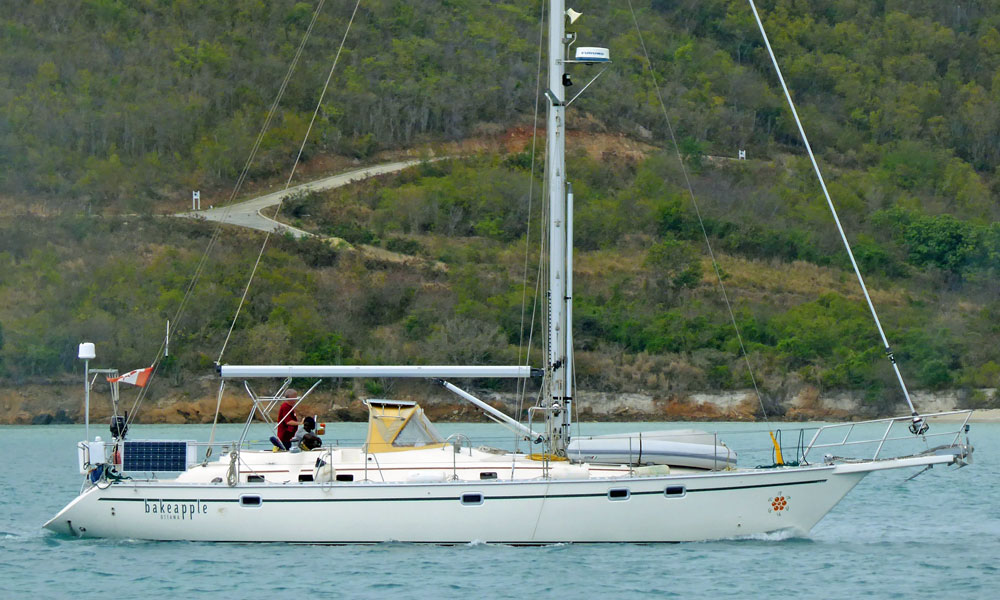
Recent Articles
Pearson 33 for sale
Sep 04, 24 03:29 PM
Apla 42 Sailboat Specs & Key Performance Indicators
Aug 30, 24 02:51 AM
Ovni 445 Sailboat Specs & Key Performance Indicators
Aug 29, 24 03:44 AM
Here's where to:
- Find Used Sailboats for Sale...
- Find Used Sailing Gear for Sale...
- List your Sailboat for Sale...
- List your Used Sailing Gear...
Our eBooks...

A few of our Most Popular Pages...

Copyright © 2024 Dick McClary Sailboat-Cruising.com
Sign-Up for News & Stories
Stephens Waring Yacht Design
Spirit of Tradition Yachts Designed In Maine
Home » News » SWD News & Stories » Keeping Up With The Cal 40
Keeping Up With The Cal 40
Posted on March 25, 2022 and filed under SWD News & Stories

The Lockheed C-130 Hercules first launched in 1955 as a cold war crusader but has gone on to become a staple of modern aviation. Because of its unique adaptations and innovations including upgraded engines, revised wing shape, and avionics, it will become the first military aircraft to stay in continuous service for a hundred years. Photo credit: Lockheed Martin
It’s been a while since we had a good stir-of-the-pot to get us fired up about something other than politics and the news for a minute. So we figured why not throw our paw in the familiar beehive of that argument for a full re-imagining of a dear, beloved classic: the Cal 40.
This isn’t our first soiree into the merits of putting new life into a design released the same year that JFK was assassinated, and the Sabin oral Polio Vaccine was first distributed with a lump of sugar to kids across the US. In fact, we’ve jumped into the deep end twice and received a massive response (the good, the bad, and the ugly) each time.
In our first article , we put Cal 40 owners on notice that it was time to address the lingering design issues and suggest a path to update these treasured boats for the 21st century. We outlined an array of points in our brief that called out details including wide-ranging weights across the fleet, dated sails and rigs, cumbersome deck layouts, the (OMG) kooky cockpit ergonomics, and quirky mechanical choices. We also identified some rigging problems that continue to make us a little seasick when we think about the prospect of amateur sailors taking their Cals hundreds of miles offshore… even on a good weather day. Other than that, great boats!
The overwhelming response to this first piece (one of our biggest ever) prompted us to draft a follow-up response , where we doubled down on the details and costs of a full Cal 40 reboot. Our full menu of updates included new rigging, sails, keel, rudder, cockpit and sailing hardware, interior, propulsion/systems, and paint. The whole enchilada, including design fees and labor, came to $350-$375K all in. A big pill to swallow until we compared it to the price of a comparable custom racer like the The Solo 38P (also a great choice).
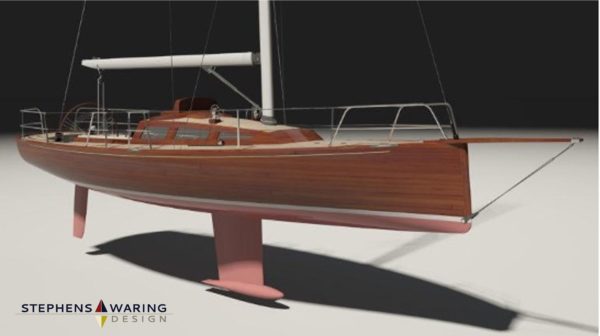
Originally created as a daysailer, Solo is all about style, charisma and high performance. A slightly tuned down racing yacht, Solo has conservative draft and a punchy sail plan that promises a lively sailing experience.
So, if our first article outlined the ingredients of the design brief, and the second article the recipe for success –consider this a reveal of baking the cake, itself… at least a rendering of it.
Your Cal 4040 Cake
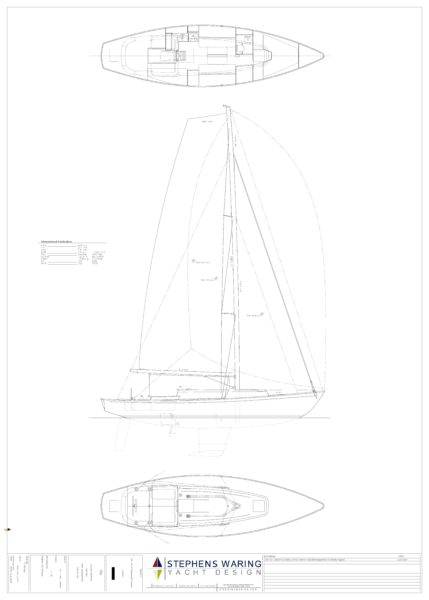
The Cal 4040 Concept by Stephens Waring. Note, the cockpit arrangement, updated underbody, and the boost in plumage.
Deck and Cockpit
Almost all practice of design most certainly involves the necessity to iterate and refine. It’s not lost on us, here, that if given the chance perhaps the creator of the CAL 40, C. William (Bill) Lapworth, would have revisited many details of the boat to bring all enhancements possible to the table. As we carve up this turkey, the way in which we’ve learned to experience sailing and how we aim to dovetail the work with the pleasure of sailing, it’s important to point out that it’s only natural to learn from what has been done before you.
Having that history is a great power. One of the most important improvements we can make to a design is to focus on the comfort of the crew and operators aboard the vessel. This has a direct relationship to safety concerns and ergonomic comfort that are intrinsic to the health and stamina of people on board. We pointed to the Cal 40’s flawed cockpit in our first story, and this project gave us the opportunity to re-imagine how the handling of the boat improved by simply tuning in a thoughtful sailing platform.
The original layout placed a lengthy tiller in the middle of the cockpit well, and positioned the helmsman forward. The parallel and poorly shaped settees leftover then become quickly filled with feet and lines and the remaining elbows flailing about on all sides makes for a glitchy situation – generally causing all kinds of traffic flow and work area issues, at best.
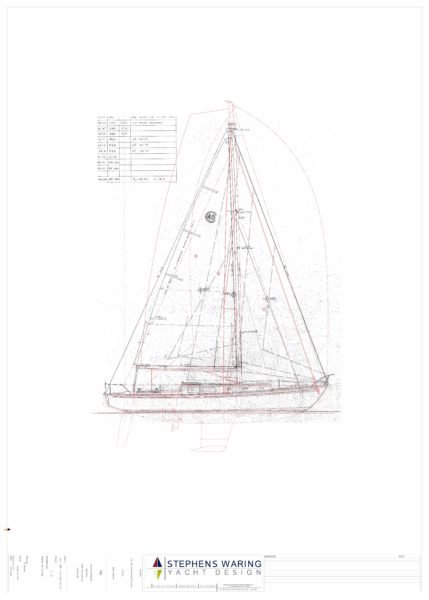
Comparison overlay of the Cal 40 and Cal 4040 Sail Plan.
Our thought here was to parse out a cockpit that shelters the helmsman out of the way of traffic and gives a proper pit area for the management of sail handling. Note, on the drawing, how we have almost 3 separate sections: settees forward, winches and line pit to the middle, and steering/navigating aft. All sailing hardware is organized throughout the deck arrangement to provide good access to halyards, sheets, trimming tweaks with good visibility and elbow room for all.
Sails and Rigging
The design of the sail plan is the larger departure in the campaign to update the CAL 40. In our article we propose a taller rig where, proportionately, we have most of the sail area concentrated in the main and a 105% working jib for easy handling and quick tacking. In light air, or close reaching, a Code 0 or Windseeker style sails are hoisted on top-down furling outside the headstay. The idea with this rig configuration is to get away from burdensome sail inventories–those days of multiple overlapping headsails are gone (gladly). And significant handling advantages are realized from the low-drag-high-lift nature of a trapezoid wing shape from the sq. head in the main. Reducing sail inventory is easier work on the crew and this matriculates into a simpler streamlined design brief for the rig — the lower drag wing shape in plan-form greatly reduces heeling forces on the yacht and are able to translate the lift energy more directly into driving force that benefit sailing angle and speed.
In this plan, the rig supports that square-top Main by eliminating the backstay and positioning heavily swept spreaders that locate shrouds and chainplates further aft at deck level and out to the rail of the boat – this wide-angle geometry actually reduces loads delivered into the hull and provides a nice wide shroud base for good support of the spar. The reduction of all these stresses on the hull and up the rig mean lighter stays, turnbuckles and tube weights. With that staying arrangement, and the lighter, stiffer carbon spar, the overall weight aloft is further reduced compared to the original Cal 40 rig specs. When we match this to a more practical sail inventory, the net result of all these tweaks moves the vertical center of gravity downward, drives the weight of the craft downward, and generally reduces or mitigates certain highly loaded areas on hull and rig. Now, what is wrong with that picture?
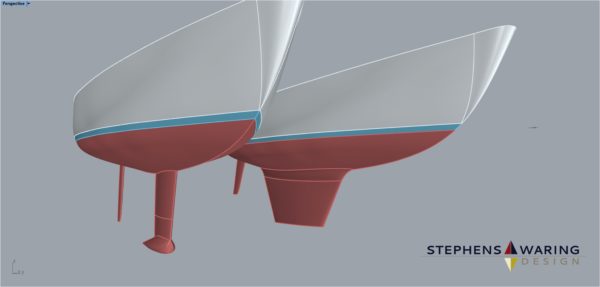
The Cal 4040 replaces the inefficient original underbody design with a modern foil-shaped fin with bulb and foil shaped rudder.
The antiquated, under-specified spade rudder is swapped for a deeper, higher aspect modern foil. A plan form like this is a strong and efficient solution for steering under the boost of canvas we have in the proposed sail plan. A rudder like this delivers precision handling in all conditions and is intrinsically linked to the balancing of the boat and drive provided by interacting between sails and keel.
The original keel on a Cal 40 is a monster. By modern-day approaches, its lateral plane area represents nearly 2.5 times the area we would normally anticipate matching to the sail area in the original design. Additionally, that old keel is not fashioned into a quality foil shape, but is more a crude imposter: the unfair surfaces show little symmetry to centerline and appear bent and warped to an approximate foil curvature that is paired to a poorly shaped leading edge. These bullet points add up to a terrible solution that mostly results in drag on the boat.
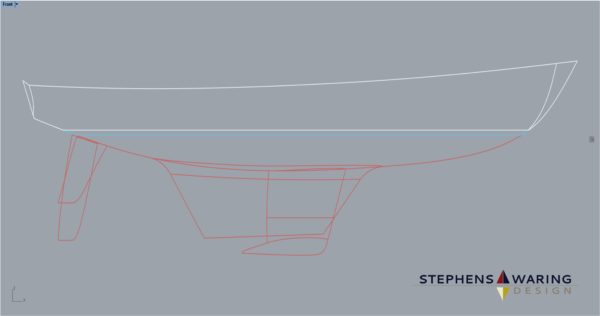
Cross-section comparison of the Cal 40 and Cal 4040 keel and rudder design.
In the proposal, the dated keel is removed and the boat is fitted with a modern foil-shaped fin that’s more suited to the job of responding to the sail area above. The design effort becomes two-fold: first is to increase the efficiency of the fin through proper foil-shaping and reduction in the plan-form area; then, carve a refined bulb shape that concentrates the ballast as low as possible. The result produces a significant decrease in wetted surface and a more capable fin on all points of sail. Going towards this deeper-draft, updated, keel, we not only reduce ballast weight and retain righting moment, but the added benefit of increased handling capability improves maneuvering and sailing across the board.
An interesting aside: analysis of the fleet illustrates a glaring, wide-range of bare-boat hull weights –nearly 4500 lbs difference across extremes. This is certainly an issue for racers thinking about viewing the class as a one-design and is most certainly a headache for handicapping. We suspect most of this resides in loose construction management over the production years. Yet, it’s always best to approach the design and build by specifying sensible materials approaches and build techniques that can give us good light structures.
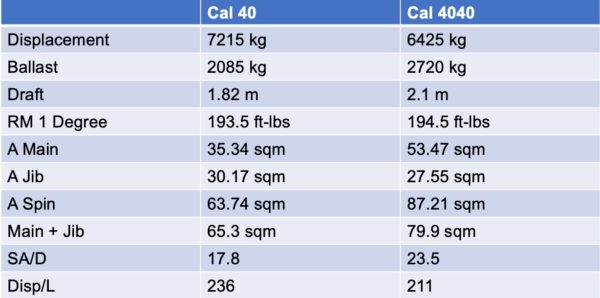
Cal 4040 Updates by Category:
- Revised geometry in hoist and boom length.
- Carbon mast, SS rigging, no back stay.
- Square-top main for more efficient horsepower.
- Solent head, Code zero Headsail in outer position, 105 working jib on inner stay.
- top Main, 105 Jib, Code Zero, A-sail launcher.
- Not too finicky, yet very efficient updated foil with shorter chord.
- All lead concentrated in the bulb.
- Revise structural hull grid for new keel.
- Again, not too finicky, yet efficient, updated plan form.
- Fine-tuned for single/dbl-handed racing, some reconstruction required.
- Sheets & halyards lead to helm for sailing with minimal crew.
- Consider: add wheel steering, and definitely an autopilot.
- Revise layout to remove all unneeded structure. Very light and spare is key.
- Suited for dbl hand racing, no frills.
- Sail drive, 30 hp Volvo or Yanmar.
- Small fridge, with cooktop and galley area.
- Upgraded navigation gear.
- Integrated flywheel genset (IFG)
- Light lithium batteries.
- Consider electric motor/hydrogenerator! Like the big boys and girls in the Open 60’s.
Borrowing from our friends in the aviation industry who brought us the C-130 Hercules (first flight: 1954), the Boeing B-52 Stratofortress (first flight: 1952) and the Boeing 737 (first flight: 1967), all of which remain aviation stalwarts with no foreseeable plans for retirement, we too believe the Cal 40 can live on in perpetuity. But like its aircraft brethren, the Cal 40 future requires updates and upgrades to remain relevant, reliable, and radical for the next generation.
Links to previous Cal 40 Articles
The Cal “4040”
Cal 4040 or Solo: You Decide
site by: slickfish studios
Review of Cal 40
Basic specs..
The hull is made of fibreglass. Generally, a hull made of fibreglass requires only a minimum of maintenance during the sailing season.
The Cal 40 is equipped with a fin keel. A boat with a fin keel is more manoeuvrable but has less directional stability than a similar boat with a full keel.
The keel is made of lead. Compared with iron, lead has the advantage of being 44% heavier, which allows a smaller keel and hence less water resistance and higher speed.
The boat can enter most marinas as the draft is just about 1.71 - 1.81 meter (5.61 - 5.91 ft) dependent on the load.
The boat is typically equipped with an inboard Perkins 4.108 diesel engine
Sailing characteristics
This section covers widely used rules of thumb to describe the sailing characteristics. Please note that even though the calculations are correct, the interpretation of the results might not be valid for extreme boats.
What is Theoretical Maximum Hull Speed?
The theoretical maximal speed of a displacement boat of this length is 7.4 knots. The term "Theoretical Maximum Hull Speed" is widely used even though a boat can sail faster. The term shall be interpreted as above the theoretical speed a great additional power is necessary for a small gain in speed.
Sailing statistics
This section is statistical comparison with similar boats of the same category. The basis of the following statistical computations is our unique database with more than 26,000 different boat types and 350,000 data points.
What is a Ballast Ratio?
What is Displacement Length Ratio?
What is SA/D (Sail Area Displacement ratio)?
Maintenance
Are your sails worn out? You might find your next sail here: Sails for Sale
If you need to renew parts of your running rig and is not quite sure of the dimensions, you may find the estimates computed below useful.
| Usage | Length | Diameter | ||
| Mainsail halyard | 31.8 m | (104.2 feet) | 12 mm | (1/2 inch) |
| Jib/genoa halyard | 31.8 m | (104.2 feet) | 12 mm | (1/2 inch) |
| Spinnaker halyard | 31.8 m | (104.2 feet) | 12 mm | (1/2 inch) |
| Jib sheet | 12.2 m | (40.0 feet) | 14 mm | (0.55 inch) |
| Genoa sheet | 12.2 m | (40.0 feet) | 14 mm | (0.55 inch) |
| Mainsheet | 30.5 m | (100.0 feet) | 14 mm | (0.55 inch) |
| Spinnaker sheet | 26.8 m | (88.0 feet) | 14 mm | (0.55 inch) |
| Cunningham | 5.3 m | (17.5 feet) | 12 mm | (1/2 inch) |
| Kickingstrap | 10.7 m | (35.0 feet) | 12 mm | (1/2 inch) |
| Clew-outhaul | 10.7 m | (35.0 feet) | 12 mm | (1/2 inch) |
This section is reserved boat owner's modifications, improvements, etc. Here you might find (or contribute with) inspiration for your boat.
Do you have changes/improvements you would like to share? Upload a photo and describe what you have done.
We are always looking for new photos. If you can contribute with photos for Cal 40 it would be a great help.
If you have any comments to the review, improvement suggestions, or the like, feel free to contact us . Criticism helps us to improve.
| - LAYC Opening Day - Newport to Ensenada - NHYC Opening Day - LBYC to Ship Rock - Seal Beach to Dana Point - Santa Barbara to King Harbor - LAYC Howlands Layover | |
| As with all sections on this website, this area depends on input from the members. If you have anything that would fit these subject areas, please pass it along to me. Thanks, Fin. Though now an old and dated design, the Cal 40 was a hot boat when new, and she carries that legacy. Written by Darrell Nicholson for and reprinted. Thunderbird, a Cal 40 owned by IBM president T. Vincent Learson, took first in fleet over 167 boats in the 1966 Bermuda Race. Because this was the first computer-scored Bermuda Race, Learson got a lot of gaff about the IBM computer that had declared him the winner—and about beating out his boss. Thomas J. Watson, IBM’s chairman of the board, sailed his 58′ cutter, Palawan, second across the line, but ended with second in class, 24th in fleet, on corrected time. In fact, the computer scoring system was not especially kind to Learson. Both he and Watson would have fared considerably better under the old system that calculated scores from the NAYRU time allowance tables. Thunderbird’s victory was a legitimate win, another in a stunning series by Cal 40s that was establishing the boat as a revolutionary design. The first Cal 40 was built for George Griffith in 1963. That winter, hull #2, Conquistador, took overall honors in the 1964 Southern Ocean Racing Circuit (SORC). The Transpac races of 1965, ’66, and ’67 all went to Cal 40s. Ted Turner’s Cal 40, Vamp X, took first place in the 1966 SORC. In the ’66 Bermuda Race, five of Thunderbird’s sisterships finished with her in the top 20 in fleet, taking five of the first 15, four of the first nine places. And so on. In their first few years on the water, Cal 40s chalked up an astonishing record. The 40 was the fifth in a line of Cal designs that C. William Lapworth did for Jensen Marine of Costa Mesa, California. Lapworth had already designed a series of moderately successful racing boats, the L classes, including an L-24, L-36, L-40 and L-50, when he teamed up with Jack Jensen. The Cal designs were built on concepts he had tried in his Lclass boats. The first Cal was the 24, Jensen’s first boat, launched in 1959. The Lapworth-Jensen team then produced a 20, 30, and 28 before getting to the Cal 40, which proved to be a successful distillation of Lapworth’s thinking up to that time. Aspects of the boat that departed from the conventional wisdom were her light displacement, long waterline, flat bilges to encourage surfing, fin keel and spade rudder. The masthead rig is stayed by shrouds secured to chainplates set inboard of the toerail, a then unusual innovation that allows a reduced sheeting angle. The success of the design helped legitimize fiberglass as a hull material, establish Jensen Marine as a significan't builder of fiberglass boats, and propel Lapworth to the forefront of yacht design. Three decades have passed since Lapworth drew the Cal 40. In that time, using computers to score races has become commonplace—boat measurers and designers would be paralyzed without them. The CCA Rule, the NAYRU tables and the Portsmouth Yardstick have been replaced by IMS, IOR, and PHRF, with the effects of their parameters expressed in the shape, size and weight of new boats. New building materials and techniques have changed the meaning of terms such as “light displacement,” “long waterline,” “fin keel,” and “fast sailboat.” Today the Cal 40 is a dated design, having been surpassed in her revolutionary features by her descendents. She remains among the esteemed elite of racing yachts, but she is not especially light, long on the waterline, or fast compared to current designs. The Cal’s builder was transformed by time, as well. Jensen Marine was bought by Bangor Punta Marine, and the Cal production line was moved to Florida about the time that the Cal 40 went out of production in 1972. For the next decade, the company’s name and address shifted between combinations of Cal, Bangor Punta and Jensen in California, New Jersey and finally Massachusetts, where it joined O’Day under Bangor Punta’s umbrella in the early 1980s. After 1984 the company was called Lear Siegler Marine, Starcraft Sailboat Products, and finally emerged as Cal, a Division of the O’Day Corporation, in Fall River, Mass. Cal and O’Day ceased production in April, 1989. The construction of the Cal 40 is typical of Jensen Marine boats of the 1960s. The hull is solid hand laid fiberglass with wooden bulkheads and interior structures. Strips of fiberglass cloth and resin secure the wooden structures to the hull, but this tabbing is rather lightweight and has been reinforced in some Cal 40s where it has failed. If it has not been reinforced, it probably needs it. Because saving weight was a priority in building the Cal 40, the reinforcement provided by the bulkheads and furniture is critical to hull stiffness. Failure of the bonding can be a significan't structural concern. The hull-to-deck joint is an inward-turning hull flange, upon which the deck molding is bonded, then through-bolted and capped with a throughbolted teak toerail. This is a strong type of joint, but there is some complaint of minor leaking along it in a few boats. The leaks are most likely one result of the relatively light construction of the hull skin, which has a tendency to “oilcan” in heavy weather, creating stresses at the joint. The deck, also a solid fiberglass layup, has reinforcement designed into it during layup, so no interior metal backing plates are provided under winches, cleats, and other hardware. PS generally recommends backing plates behind high-stress hardware as a matter of course. We found little indication of trouble with leaking or working of most of the fittings, but one owner said that his lifeline stanchion bases had to be reinforced. This would be an area to inspect carefully. Colors and non-skid surfaces are molded in, but due to the age of any Cal 40, the finish will look tired unless it has been renewed. A good Awlgrip job will do it wonders, and is probably warranted for this boat unless it is in general disrepair. The deck and cockpit of the Cal 40 we inspected have numerous cracks in the gelcoat in corners and other stress areas. Check these areas closely—they are unsightly, but in most cases are not a structural concern. Ballast is an internal lead casting dropped into the keel before the insides were assembled. If there is evidence that the boat has suffered a hard grounding, invesitgate the ballast cavity to see that it was properly repaired. It should not have a hollow sound when rapped, and there should be no cracks, weeping, or other evidence of moisture inside. Due to the construction sequence, major repairs could be awkward. Wiring was also installed prior to the interior, which makes it quite inaccessible in some areas. What may be of more concern is that it is low enough in the boat to get wet if the last watch forgot to pump the bilges and the boat heels over to her work. That’s what happened to one owner, who lost all the electricity on the boat when approaching Nova Scotia’s Bras d’Or Lakes after an all night sail. Fortunately, dawn arrived in time to avert a navigation problem. They anchored in the harbor and found that the electrical system worked fine, once it got dry again. Before the next season rolled around, the boat’s entire electrical system had been replaced in elevated, accessible locations. The implication is that you should look carefully at the wiring in a Cal 40 before you make any decisions. If it has been replaced, try to learn who did the work and how well qualified he/she was for the job. If it has not, you may have to work the cost of rewiring into your acquisition expenses. We would suspect the worst until proven otherwise. You might expect wheel steering on a boat this size, but the stock Cal 40 came with a big tiller. The boat is well enough balanced to be controlled with a tiller, and many helmsmen prefer it to a wheel, which masks feedback from the rudder and makes sensitive steering more difficult. The cockpit is roomy, but properly designed for offshore work with relatively low volume, a bridgedeck and small companionway. The tiller sweeps the cockpit midsection, allowing the helmsman to sit fairly far forward, a help to visibility. Winch islands are located aft of the helmsman, where there is room for the crew, but it also makes the sheets accessible to the helmsman for shorthanded sailing. The teak cockpit coaming has cutouts giving access to handy storage bins. The aluminum mast is stepped through the deck to a fitting that meets it at the level of the cabin sole. The shroud chainplates are secured to a transverse bulkhead at the mast station, and then tied into an aluminum weldment in the bilges. This weldment also supports the mast step. While chainplates have been an area of concern in some designs, because they can work under the large loads they carry, our indications from Cal 40 owners are that the chainplate/shroud/mast step attachments have served well. The Cal 40 is in her element in heavy air, especially off the wind. Her long waterline and flat bilges help her get up and go on reaches and runs, surfing in heavy air. On the wind, the flat hull forward pounds in waves and chop, which slows the boat somewhat and is irritating. Owners agree that she sails best with the rail in the water. She is not dry on the wind, so a dodger is a welcome feature. The masthead sailplan allows relatively easy reduction of headsails to suit heavier conditions, and Cal 40 owners extol the survivability of their boats. “Simple rig, nothing breaks, strong, easy to use,” is a typical comment. Despite her stellar racing record, the Cal 40 is only ordinary in performance by today’s standards. She carries a PHRF rating between 108 and 120 seconds per mile, depending on the region. That’s about the same as a C&C 38 or an Ericson 36, both IOR designs of the late 70s. Compared to a mid-1970s design such as the Swan 38, the Cal 40 is a bit slower on the wind and in light air, a bit faster off the wind and in heavier going, about equal in speed overall. It’s not surprising that these boats perform alike if you look at the length of their waterlines and their displacements. In comparing the Cal 40 to boats of her own vintage one sees what all the fuss was about. The Columbia 40, for example, is a 1965 Charles Morgan design, an “all-out racer” with a 27′ waterline, displacement of 20,200 pounds, and a PHRF rating of about 170. Or look at the Hinckley 41: 29′ on the water, 18,500 pounds, PHRF about 160. The Cal 40’s waterline is almost 31′, but she displaces one or two tons less than the Columbia or the Hinckley, and rates nearly one minute per mile faster under PHRF. In that context, she is indeed a fast, light displacement boat with a long waterline. Just look at her “fin keel” and you can see the progression. Compared to a full keel with attached rudder, it is small. Compared to a modern fin keel, it hardly seems small enough to qualify for the name. If Cal 40s win races today, it’s because they are well sailed, not because the boat is the fast machine on the race course. In the 60s, “accommodations” tended to imply the number of berths in a sailboat, and the more the better. It also included the notion of a basic galley with sink, stove, icebox, and a table of sorts, plus a head with toilet and sink. Space age electronics had not arrived in the galley or the nav station, nor had space arrived in the concept of the main saloon. Inside, as elsewhere, the Cal 40 is well designed and functional, but she speaks of her own era. The layout is very traditional, with a V-berth forward, separated from the main cabin by a head and hanging locker. Pilot berths and extension settees port and starboard provide sleeping for four. The dropleaf table seats four, six if you squeeze. Next aft is the galley to port and a nav station to starboard, consisting of a chart table over the voluminous icebox. The galley has a usable sink next to the well for a gimbaled stove with oven. Flanking the companionway steps are the entrances to the quarterberths, known affectionately as “torpedo tubes,” which gives you an impression of their dimensions. They extend from the main cabin through to the lazarette, which allows good circulation of air. In fact, on a return trip from Bermuda, one seasick sailor found great solace between tricks at the helm by climbing into one of the cocoon-like torpedo tubes, where he was washed with a fresh breeze from the dorade vent on the lazarette cover. The fact that the quarterberths flank the engine compartment doesn’t matter as long as you are under sail, but it’s a different story when under power. So you have sleeping accommodations for eight, which is too many people on a 40-footer, except perhaps when racing. The extension transom berths, however, do not lend themselves to use under way. The interior, not spacious by modern standards, fills up fast with extra bodies aboard. Owners tend to convert some of the berths to storage space. The pilot berths are especially tempting for that use, but since they are also the most comfortable berths on the boat, the quarterberths are often sacrificed for storage. One of the best features about the Cal 40’s interior is the dining table. Set slightly to port, it is supported by a sturdy sole-to-overhead stainless steel post at each end with a 4′ 4″ gimbaled mahogany tray between them above the table. The posts make excellent handholds, and the gimbaled tray can serve for everything from salt and pepper holder to bookshelf to diaper-changing table. The table has a drop leaf to port and to starboard, so it can be set up for use from the port settee without blocking fore-and-aft passage through the boat. A variety of powerplants will be found in Cal 40s. Some early hulls were equipped with Atomic 4 gasoline engines. Later hulls got Graymarine 4-112 gasoline or Perkins 4-107 diesels. It’s likely that the original engine will need to be replaced if it has not already been done. Even the newest Cal 40s are rather old, and the early models have passed the quarter-century mark. Boats in our files have Volvo MD2B, the Perkins, Pathfinder 50, Westerbeke 4-108, and Pisces 40 from Isuzu listed as replacements for the original engine. The engine is located under the cockpit, between the torpedo tubes, which allow access to both sides, but are not especially convenient, particularly if the area has been turned into storage space. Better is the companionway ladder, which removes to expose the front of the engine. That can be an inconvenience, too, if the engine needs some attention while under way. Used for the minimum requirements of a racing yacht, primarily getting in and out of port, you can probably make do with any of the engines. If the boat is to be used for cruising, with greater demands to be made on the engine, the Atomic 4 would likely be inadequate. Generally the boat will do about six or seven knots under power, depending on the power plant and propeller. We suspect that many Cal 40s will have folding propellers, good for racing but not the best for powering, especially in reverse. The spade rudder set well aft confers good maneuverability under most conditons. The Cal 40, a hot racing boat when new, carries that legacy with her into maturity. Generally, the boats have been raced hard, some cruised hard as well.Owners have tended to be the type to add gear and modifications to keep the boat comfortable and competitive. The boats are likely to have a large inventory of much-used sails. Because of her age and dated design, a Cal 40 may be available for much less money than a newer boat offering comparable quality and performance. Prices will vary according to the condition of the boat and gear, but will likely fall in the range of $40,000 to $50,000. If the boat has lots of add-ons in the galley and nav station, modern racing hardware, renewed standing rigging, new finish on the topsides, and the bottom is in good condition, it might fetch something higher. One performance extra to look for is a special (non-factory) fairing job on the keel and rudder that was available when the boats were young. On the other hand, it should not be a surprise if there are areas that require attention, and you should calculate the cost of the work into the price you are willing to pay. Twenty or 25 years of hard sailing will take its toll. Significan't expense could be incurred if the boat needs new wiring, an Awlgrip job on the topsides, extensive reinforcement of the interior furniture tabbing, a new engine, or new rigging. If racing is in your plans, new sails might be scheduled in as well. This would be a good boat for a handy do-ityourselfer. Over the years, most of the boat’s problems have been solved more than once by other Cal 40 owners, many willing to share their wisdom. You would probably have a choice of solutions, and indications of which worked best. Although there is not currently an active owners association, there persists a loose fellowship among present and former owners. If you buy a Cal 40, you will acquire a modest boat, with good pedigree and performance, and—should you desire them—a few new friends, as well. Dear Friends, As many of you know, when Super Storm Sandy devastated New Jersey in October, 2012, one of the many casualties was the Cal 40 two-time Newport to Bermuda champion. Declared a total loss by the insurance company, Pete Rebovich decided to buy the boat back and try to repair it for the 2014 Bermuda Race. We thought our sailing friends and colleagues might be interested in the progress to date. The link below is to the Raritan Yacht Club website, where we are starting a Sinn Fein Restoration blog. The intended audience is our club members, so It’s a bit chauvinistic, but should nonetheless be of broader interest. Questions or comments may be e-mailed to Kelly Robinson at . I will forward to Pete as appropriate.
By | Published: September 11, 2012
George Griffith rocked my world. The man had a vision for a next boat, and he didn’t care about the doubters. The result was the Cal 40, arguably the most influential raceboat of the second half of the 20th century, and I have it on good authority that George, on his last day of sharing our Blue Planet, had a view of some very fine Cal 40s, moored at Catalina Island, gleaming as brightly as when they rolled off Jensen Marine’s production line in the 1960s.
George Griffith died this morning at about 5 a.m. aboard his motorboat with the family rushing him to the mainland. His son David reports they were making 19.5 knots, and knowing , that means that someone was trying to push the throttles through the housing. A few miles short of the beach, George simply fell asleep. The last two weeks however, had been full of family time, shared aboard at Catalina with wife Mille, son David, daughter Mary, grandchildren, and a stream of admiring visitors from boats nearby. As longtime members of the Los Angeles Yacht Club, George and Mille made great use of the club’s mooring field at Howland’s Landing, Catalina. They had mooring number three, and you couldn’t really say whether was their second home, or Howland’s, but you could say without reservation that George was the patriarch. Born May 9, 1921, George built himself a nine-foot dinghy in 1931. You do the math. He sailed his first Transpac in 1941, sharing the 45-foot cutter with his brother, Dave, and finishing second on corrected time. World War II he spent in Houston, Texas building warships.
Caltech was the logical place for George’s higher education, feeding that hands-on, experimental bent that never left him. He worked with friend and naval architect Bill Lapworth on the design of a 36-footer, and then a 40-footer, but it was George who sketched out the shallow sections of what would become the Cal 40 at a time when “walking on the bottom of the boat wasn’t exactly normal.” He insisted upon the fin keel, spade rudder and light-for-its-time construction that would make this boat the original downwind flyer. It was George who boldly told the builder, “I’ll guarantee you ten boats.” Not that he had a way to back that up, exactly. David recalled that, as hull number one neared launch, “Dad drove the muffler right off our Studebaker station wagon and just kept right on going.”
Then, in the very next Transpac, 1965, Los Angeles to Honolulu, Cal 40s finished 1-1, 2-2, 6-3, and 5th-7th in Class C. Downwind distance racing has never been the same. George sailed the race on overall winner with a crew including skipper Don Salisbury, navigator Ben Mitchell, and builder George Jensen . . .
Today, is yet another Cal 40 that is still as good as new and still pleasing to the eye, the nautical equivalent on the mooring of a ’65 Mustang in the driveway. Many years on, Cal 40 owner Stan (“Cal 40s have no bad habits”) Honey inspired a fleet of 14 Cal 40s to race the Centennial Transpac, sailed in 2005. George’s son David joined the crew of Fin Beven’s , and the run down the Molokai Channel proved the whole concept all over again . . .
The motorboat came about in 1985, when Mille put her foot down. George recalled, “I’ve always thought that if the wind is aft, a boat should have a spinnaker up. We got to a point where Mille declared that I had risked my neck too many times getting a spinnaker down when I shouldn’t have put it up in the first place.” And , which wound up being built at Choate’s with George as yard boss, is a motorboat that a sailor could love. There will be a memorial service at 5 pm on Sunday at the Los Angeles Yacht Club in San Pedro. Ashes will be scattered off the West End of Catalina, the last mark before Diamond Head. George had for years been Transpacific Yacht Club member number one, which he said, “Just means I’ve lost a lot of friends.” So have we, George, so have we. and selecting "Save Target As" from the new menu that appears before you. by right-clicking on the link and selecting "Save Target As" from the new menu that appears.Published in A Brief History... Download Below or visit the blog page at [1.04Mb] Download Below [8.51Mb] By Lynn Fitzpatrick Credit: Sinn Fein, Peter Rebovich’s Cal 40 from Metuchen New Jersey, beat the other ten boats in Class 1 and the entire 123-boat St. David’s Lighthouse Division for top honors in the 2008 Newport Bermuda Race. This is Rebovich’s fourth successive Class 1 win and his second lighthouse win in a row. In addition to claiming the St. David’s Lighthouse Division victory, Sinn Fein is the first boat ever to win the North Rock Beacon Trophy, which was donated this year by the Royal Bermuda Yacht Club for the winner on corrected time among all of the 122 IRC-rated boats in the combined St. David’s and the Gibbs Hill Lighthouse Divisions. Sinn Fein, pronounced “Sin Fin” by the renegades from Raritan Yacht Club, placed first in Class 1, the small boat group, in the 2002, 2004 and 2006 Newport Bermuda Races. The crew has been together for several Bermuda Races with five of the seven members having been on the 2002 team and all of them having been aboard for the Centennial Newport Bermuda Race in 2006, so all of them have now won Class 1 and St. David’s Lighthouse trophies The small boats had a very different race from that sailed by the big boats in the Open Division that finished the day before them. The winds were on the bow, straight from Bermuda the entire time, and were much stronger after the High that buffered the approach to Bermuda earlier in the week, had disappeared. Peter Rebovich said of his crew, “This is the best crew in the race without a doubt and this was one of the most difficult races, because it was all upwind. No one got sick, but we did have mechanical issues. It was an unexpected win because we lost our electronics when we swamped the computer and lost use of our satellite phone. We could navigate, but we couldn’t communicate. It was a total surprise!” Sinn Fein’s elapsed time or 104:43:57 corrected at 61:06:38 under ORR and 100:13:44 under the IRC rule. Selkie, a McCurdy Rhodes 38, skippered by Sheila McCurdy, Vice Commodore of the Cruising Club of America, was second with a corrected time of 62:10:18. Emily, Edwin S. Gaynor’s Nielsen 44, was third in the division with a corrected time of 63:23:48. Sinn Fein’s all amateur crew is comprised of Peter S. Rebovich Sr., Gary Gochal, Henry Henning, Peter S. Rebovich Jr., Mark P. Rebovich, Kelly Robinson and Foster Tallman. Printed in November 2006 Written by Robert H. Perry for Sailing Magazine Download Below |
©2010-2020. Cal40.com. All Rights Reserved. |
| to view more of our site's pages. to view more of our site's pages.
| Bill Lapworth saw this quality in fiberglass from the start. To tell the truth, I even still like the Atomic 4 inboard engines. They start good, run good, no vibration and easy to maintain. run under the Golden Gate. "Illusion" owned by Stan Honey, is leaving San Francisco for the 1994 Transpak. If there were crew aboard, one of them might be saying "Hey!" "Stan!" "Hey, how about slowing this thing down a bit! Somethin's gonna BREAK ! ". I'm sure that anyone aboard is a little apprehensive, starting out a race to Hawaii with winds like that! It just happens that no crew was aboard to complain, Stan was singlehanding... Is this a great boat or what . . . or simply use your browser's BACK button . . . |



COMMENTS
The rig dimensions above are from the 1963 sail plan drawing. Current class rules (2005) allow a max of: I - 46.7'. J - 15.3'. P - 40.1'. E - 17.55'. The accolades for this particular boat are many. Certainly one of the most influential designs and successful racing boats ever. With 160 built, it was also a commercial success for Jensen Marine.
Cal 40 Specifications. Thunderbird, a Cal 40 owned by IBM president T. Vincent Learson, took first in fleet over 167 boats in the 1966 Bermuda Race. ... have changed the meaning of terms such as "light displacement," "long waterline," "fin keel," and "fast sailboat." Today the Cal 40 is a dated design, having been surpassed in ...
40 to 50 indicates a heavy bluewater boat; over 50 indicates an extremely heavy bluewater boat. Comfort ratio = D ÷ (.65 x (.7 LWL + .3 LOA) x Beam^1.33), where displacement is expressed in pounds, and length is expressed in feet. Capsize Screening Formula (CSF): Designed to determine if a boat has blue water capability.
The Cal 40 is a racing keelboat, built predominantly of fiberglass, with wood trim. It has a masthead sloop rig; a spooned, raked stem; a raised counter, transom; an internally mounted spade-type rudder controlled by a tiller and a fixed fin keel. It displaces 15,000 lb (6,804 kg) and carries 6,000 lb (2,722 kg) of lead ballast.
The Classic 1960s Ocean Racing Legend. The Cal 40 is a roughly 39-ft 4-in fiberglass production racing and cruising sailboat, of which about 155 were built in Costa Mesa, California, starting in 1963. The first mass-produced sailboat that was capable of sustained surfing on waves, the Cal 40 dominated ocean racing during the 1960s like no other design before or since.
Cal 40 is a 39′ 4″ / 12 m monohull sailboat designed by C. William Lapworth and built by Jensen Marine/Cal Boats between 1963 and 1971. ... The lower a boat's ratio is, the less power it takes to drive the boat to its nominal hull speed or beyond. Read more. Formula. D/L = (D ÷ 2240) ÷ (0.01 x LWL)³ D: Displacement of the boat in pounds ...
Base price seems a fair $204,950, FOB Clearwater, Florida. For comparison, a Cabo Rico 40 is close to $400,000, a Catalina 40 Mk II and a Jeanneau Sun Fast 40 about $170,000, and the C&C 121 Express about $220,000. Contact- Caliber Yachts, 4551 107th Circle N., Clearwater, FL 33762; 813/573-0627. Darrell Nicholson.
Design. The Caliber 40 is a recreational keelboat, built predominantly of fiberglass, with teak wood trim. It has a cutter rig, with anodized aluminum spars, a bowsprit, a raked stem and reverse transom, with a swing-down swimming ladder and hand-held shower. It features a skeg -mounted rudder controlled by a wheel and a fixed fin keel.
The Cal 40 developed a reputation for being a fast, downwind sailing machine very early in its history. It's easy to see why. The first hull, Persephone, was an instant success, although the design was considered somewhat radical for offshore and long-distance racing. Her flat, dinghy-like bottom, fin keel, and high-aspect spade rudder, along ...
The Cal 40 is a 39.33ft masthead sloop designed by C. William Lapworth and built in fiberglass by Jensen Marine/Cal Boats between 1963 and 1971. 108 units have been built. The Cal 40 is a moderate weight sailboat which is a good performer. It is very stable / stiff and has an excellent righting capability if capsized. It is best suited as a ...
Designer Bill Lapworth drew a radically flat bottomed boat by the standards of the early 1960s, with well balanced ends and a fin keel with a relatively long chord length. ... Cal 40 specification. LOA: 12.00m / 39ft 4in LWL: 9.25m / 30ft 4in Beam: 3.35m / 11ft 0in Draught: 1.70m / 5ft 7in Displacement: 6,800kg / 15,000lb Ballast: 2,700kg / 6 ...
The Caliber 40 is a 40.92ft cutter designed by Michael McCreary and built in fiberglass by Caliber Yachts (USA) since 1992. The Caliber 40 is a moderate weight sailboat which is under powered. It is very stable / stiff and has a good righting capability if capsized. It is best suited as a bluewater cruising boat.
The Caliber 40 LRC Sailboat. The Caliber 40 LRC, a robust long-range cruiser sailboat, is a creation from the drawing board of Michael McCreary, an American designer. This sailboat exemplifies a blend of endurance and comfort for long-distance sailing. It is built by Caliber Yachts, a company established and located in Clearwater, Florida.
These bullet points add up to a terrible solution that mostly results in drag on the boat. Cross-section comparison of the Cal 40 and Cal 4040 keel and rudder design. In the proposal, the dated keel is removed and the boat is fitted with a modern foil-shaped fin that's more suited to the job of responding to the sail area above.
It is unclear if the original 40 was produced alongside the 40 LRC or was discontinued in favor of the LRC. A total of 130 of the 40 LRCs were produced. Caliber 40 sailboat photo by Tarn Kelsey. Systems. The engine and drive train in both models were similarly sized (50 to 55-hp) Yanmar engines with Kanzaki mechanical transmissions.
The Cal 40 Used Boat Review. There may be no more than a handful of sailboats in recent history that can be called milestones in that they significantly influenced the way in which boats were designed, built and sailed. Without a doubt, the Cal 40 is one design that fits this elite group. Introduced in 1963, the Cal 40 was so successful ...
In 1963 racing boats were all over the map in terms of design, and many of them were not good boats. The Cal-40 has endured as an efficient and handsome design. This modest appearing design changed the direction of racing boat design forever." ~ Robert H. Perry Naval Architect [email protected]. Contact Information. Cal40.com [email protected]
Specifications and Review of Cal 40 based on the boat's specifications and artificial intelligense. ... The DL-ratio for Cal 40 is 240 which categorizes this boat among 'light crusers & offshore racers'. Heavy Light 54% 0 50 100. 54% of all similar sailboat designs are categorized as heavier. A light displacement requires less sailarea and has ...
Cal 40. Though now an old and dated design, the Cal 40 was a hot boat when new, and she carries that legacy. Written by Darrell Nicholson for Pratical-Sailor.com and reprinted. Cal 40 Specifications. Thunderbird, a Cal 40 owned by IBM president T. Vincent Learson, took first in fleet over 167 boats in the 1966 Bermuda Race.
The Cal 40, the boat that did it big . . . This photo happens to be a 1966 Cal 40 sloop, "Forever Young". A great name for a boat that remained just that, forever young, for the past 35 years! ... Rig specs: I=46', J=15'1", P=40', E=17'5" I got the above photo of this Cal 40 from a for-sale ad on the net. This 32 year 40 footer is selling for ...
The Cal 40 is a sloop-rigged monohull sailboat designed by Bill Lapworth and made by Jensen Marine from 1963 to about 1971. The design may be one of the first recreational sailboats designed to plane while going downwind. It is a popular race boat in California, where the boats were originally built. ... Specs. LOA: 39.33 ft LWL: 30.33 ft Beam: ...
The Caliber 40 has a fully encapsulated, elongated fin keel that has an iron and concrete ballast of 9,500 pounds. Her ballast to displacement ratio is a very respectable 44% which is good to find on a boat intended for bluewater use. The rudder is skeg hung for protection and tracking and her waterline is just over 32 feet.
Specs; Contact; Photos; Description; ... Whether you're a seasoned sailor or new to the world of sailing, the '68 Cal 34 is an ideal choice. Offering an affordable price point, this boat presents a fantastic opportunity to kickstart your sailing journey or find a comfortable live-aboard option. ... 40-50: heavy bluewater boat >50: extremely ...
Sailboat Specifications Definitions Hull Type: Fin w/spade rudder: Rigging Type: Masthead Sloop: LOA: 25.00 ft / 7.62 m ... A completely different design from the later Cal 2-25. Photo courtesy of Adam Hunt. Sailboat Forum. View All Topics: ... 30 to 40 indicates a moderate bluewater cruising boat; 40 to 50 indicates a heavy bluewater boat;